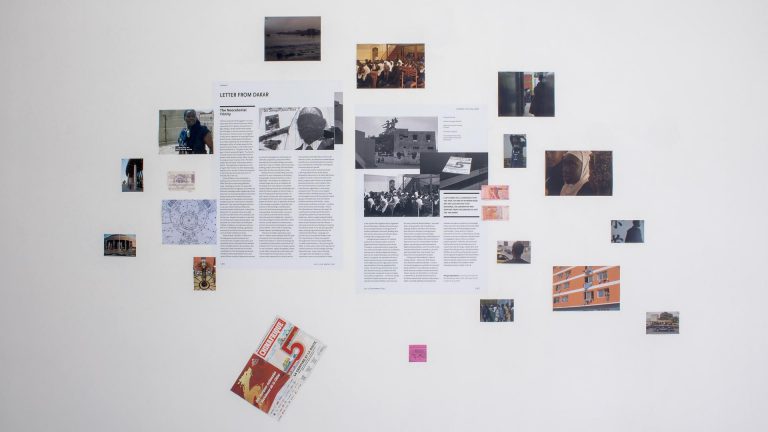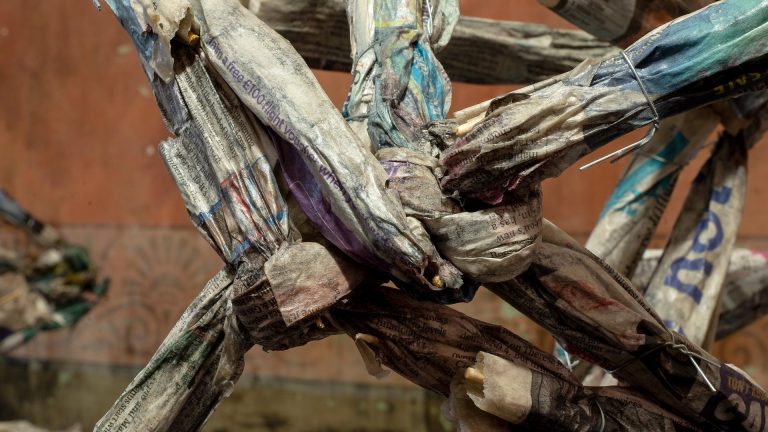Artist: Dan Rees
Exhibition title: Disguised as a Dog
Venue: Assembly Point, London, UK
Date: September 7 – October 13, 2018
Photography: all images copyright and courtesy of the artist and Assembly Point, London
Disguised as a Dog — Dan Rees
In its ancient form the ‘Cynics’ displayed an unparalleled earnestness and commitment in their doggedness (‘cynic’ derives from ‘kuŭnĭkós’ a Greek word meaning ‘dog-like’) towards freedom of the ‘self’ from institutionalised forms of power. In its modern form cynicism can be understood as resulting from a levelling of values, personal and objective, leading to nihilistic tendencies permeating culture which is predominated by the escapist mechanisms of the culture industry[1].
If all things have gestures and modes of behaviour inscribed in them, then what about something so porous as chalk? Implicit in the concept of the philosophical fragment associated with Jena Romanticism is the idea of construction and the ruin. Just like rock, thoughts can ossify to the point of impenetrability or can erode and dissolve into the maelstrom. If slippers are monuments to the ‘hatred of bending down’ and tying shoelaces, do the fragmented rocks on a Dover beach become like oversized souvenirs of the Berlin Wall?[2] If so, when did the White Cliffs of Dover become a symbol of totalitarianism and oppression?[3] The ‘Valleys’ were hotbeds of political radicalism, the symbol of the red flag of Socialism, (a bed sheet dipped in pig’s blood), originated on the foothills of Merthyr Tydfil. In 1986 at the height of their defeat, the political activists of South Wales looked towards Nicaragua. Paul Robeson Jr was the guest speaker at the inaugural meeting of the ‘Wales Nicaragua Solidarity Campaign’.
This type of internationalism, the spontaneous creation of ties where before none were obvious, functions as a mimetic construction of the ontological relations that Adorno claims to be present in works of art. The speculative bubble associated with abstract painting has made it the least institutionally acceptable type of work, which must make it appealing again on some level? The usual (and valid) criticisms via-a-vis the Kantian legacy of artistic genius are also bound up in their own prejudices of taste in relation to class snobbery. When the market and taste pendulum swings in such a predictable dialectic between figuration and abstraction, between painting and not, when no position is self-evidently legitimate, the only thing left worth chasing may appear to be ‘relevance’ at any cost. This position however, contains true poverty. In the short-term, when you find yourself so artistically out of fashion it is painful to even exist, one must keep faith and consider the damage done in sacrificing deeper values in order to fit the times.
The point is not to celebrate sincerity for the sake of it; one may already be involved in a type of détournement in order to occupy an inversion of the already subverted position of art, which can lead one through negation to affirmation and back again. The risk is ending up like a double or triple agent who has forgotten which side they are on and finds nothing left to serve except self-interest[4]. ‘Diogenes of Sinope’, in adopting the mantle of the ‘dog’ and living a supposedly degraded existence, masturbating and defecating in public, serves as a reminder of the sickness contained in the irrational rationality of everyday life. In living like a dog, Diogenes’ social function was to remain ‘functionless’ and disregard the tyranny of socially constructed norms – in doing so he was performing an early version of Institutional Critique. The modern cynic could be described as the person who has forgotten which level of irony they were operating on. We may detect from the pain of failed personal encounters that when we lie most actively to ourselves, we ugly the things we care about the most. Unable to disentangle from a matrix of opposing thoughts, one may as well do like the slogan and ‘keep calm and carry on’. There may be some value in displaying the ease of co-option under neoliberalism but critique by way of gently pruning the institutional garden only deepens the malady. Of course risking one’s social status to be more like the ‘dog’ is not easy and in attempting to stand up like a nail, the chances are you will be crushed by other desperate minds locked in their own internal acts of self-exploitation, distancing themselves all the while from the very things they once held dearest. What might inadequately be described as ‘connecting with nature’ is better understood as a momentary communion with our non-rational ‘animal’ self, which like a trapped echo still rattles around inside us. When my Grandmother could no longer walk, her access to fresh air became limited. I would take her in the wheelchair outside into the garden of the care home. As the door opened she would close her eyes and tilt her head back as if listening to her favourite song and let out a gentle groan as the air touched her skin.
[1] Peter Osborne’s essay ‘Disguised as a Dog’ for the further philosophical explanation of the relationship between the ancient ‘Cynics’ and cynicism in its modern usage. Osborne’s essay provided the initial inspiration for the ideas in this text. ‘The Postconceptual Condition’ Verso, 2018.
[2] Theodor Adorno, ‘Minima Moralia’, p110, Verso, 2005.
[3] See Ukip’s ‘No Border. No Control’ campaign.
[4] Peter Sloterdijk ‘Theory of the Double Agent’ p113, ‘Critique of Cynical Reason’, University of Minnesota Press, 1987.





























